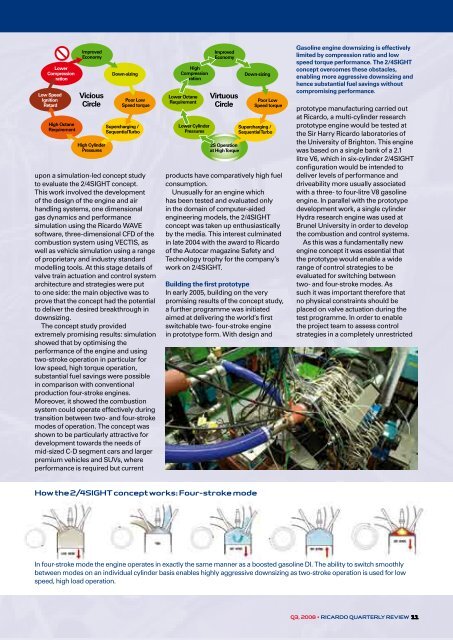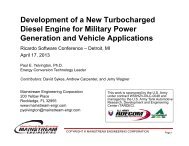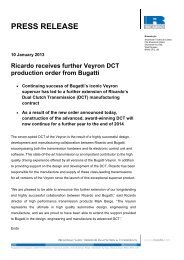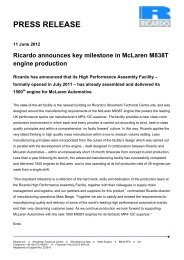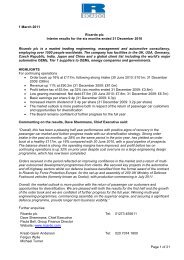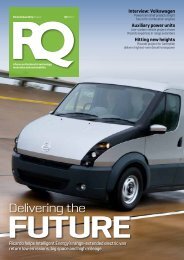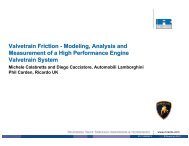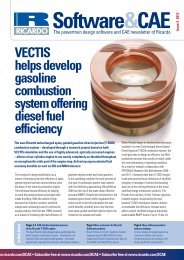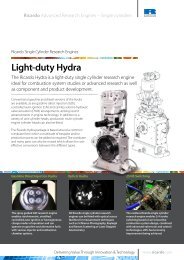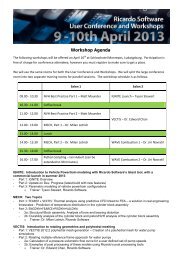Case Study - Ricardo
Case Study - Ricardo
Case Study - Ricardo
Create successful ePaper yourself
Turn your PDF publications into a flip-book with our unique Google optimized e-Paper software.
Lower<br />
Compression<br />
ration<br />
▲<br />
Low Speed<br />
Ignition<br />
Retard<br />
▲<br />
High Octane<br />
Requirement<br />
▲<br />
▲<br />
Improved<br />
Economy<br />
Vicious<br />
Circle<br />
▲<br />
upon a simulation-led concept study<br />
to evaluate the 2/4SIGHT concept.<br />
This work involved the development<br />
of the design of the engine and air<br />
handling systems, one dimensional<br />
gas dynamics and performance<br />
simulation using the <strong>Ricardo</strong> WAVE<br />
software, three-dimensional CFD of the<br />
combustion system using VECTIS, as<br />
well as vehicle simulation using a range<br />
of proprietary and industry standard<br />
modelling tools. At this stage details of<br />
valve train actuation and control system<br />
architecture and strategies were put<br />
to one side: the main objective was to<br />
prove that the concept had the potential<br />
to deliver the desired breakthrough in<br />
downsizing.<br />
The concept study provided<br />
extremely promising results: simulation<br />
showed that by optimising the<br />
performance of the engine and using<br />
two-stroke operation in particular for<br />
low speed, high torque operation,<br />
substantial fuel savings were possible<br />
in comparison with conventional<br />
production four-stroke engines.<br />
Moreover, it showed the combustion<br />
system could operate effectively during<br />
transition between two- and four-stroke<br />
modes of operation. The concept was<br />
shown to be particularly attractive for<br />
development towards the needs of<br />
mid-sized C-D segment cars and larger<br />
premium vehicles and SUVs, where<br />
performance is required but current<br />
▲<br />
High Cylinder<br />
Pressures<br />
Down-sizing<br />
▲<br />
▲<br />
Poor Low<br />
Speed torque<br />
Supercharging /<br />
Sequential Turbo<br />
High<br />
Compression<br />
ration<br />
Lower Octane<br />
Requirement<br />
Lower Cylinder<br />
Pressures<br />
Improved<br />
Economy<br />
Virtuous<br />
Circle<br />
2S Operation<br />
at High Torque<br />
Down-sizing<br />
Poor Low<br />
Speed torque<br />
Supercharging /<br />
Sequential Turbo<br />
products have comparatively high fuel<br />
consumption.<br />
Unusually for an engine which<br />
has been tested and evaluated only<br />
in the domain of computer-aided<br />
engineering models, the 2/4SIGHT<br />
concept was taken up enthusiastically<br />
by the media. This interest culminated<br />
in late 2004 with the award to <strong>Ricardo</strong><br />
of the Autocar magazine Safety and<br />
Technology trophy for the company’s<br />
work on 2/4SIGHT.<br />
Building the first prototype<br />
In early 2005, building on the very<br />
promising results of the concept study,<br />
a further programme was initiated<br />
aimed at delivering the world’s first<br />
switchable two- four-stroke engine<br />
in prototype form. With design and<br />
Gasoline engine downsizing is effectively<br />
limited by compression ratio and low<br />
speed torque performance. The 2/4SIGHT<br />
concept overcomes these obstacles,<br />
enabling more aggressive downsizing and<br />
hence substantial fuel savings without<br />
compromising performance.<br />
prototype manufacturing carried out<br />
at <strong>Ricardo</strong>, a multi-cylinder research<br />
prototype engine would be tested at<br />
the Sir Harry <strong>Ricardo</strong> laboratories of<br />
the University of Brighton. This engine<br />
was based on a single bank of a 2.1<br />
litre V6, which in six-cylinder 2/4SIGHT<br />
configuration would be intended to<br />
deliver levels of performance and<br />
driveability more usually associated<br />
with a three- to four-litre V8 gasoline<br />
engine. In parallel with the prototype<br />
development work, a single cylinder<br />
Hydra research engine was used at<br />
Brunel University in order to develop<br />
the combustion and control systems.<br />
As this was a fundamentally new<br />
engine concept it was essential that<br />
the prototype would enable a wide<br />
range of control strategies to be<br />
evaluated for switching between<br />
two- and four-stroke modes. As<br />
such it was important therefore that<br />
no physical constraints should be<br />
placed on valve actuation during the<br />
test programme. In order to enable<br />
the project team to assess control<br />
strategies in a completely unrestricted<br />
How the 2/4SIGHT concept works: Four-stroke mode<br />
In four-stroke mode the engine operates in exactly the same manner as a boosted gasoline DI. The ability to switch smoothly<br />
between modes on an individual cylinder basis enables highly aggressive downsizing as two-stroke operation is used for low<br />
speed, high load operation.<br />
Q3, 2008 • RICARDO QUARTERLY REVIEW 11


